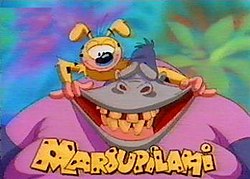Top Qs
Timeline
Chat
Perspective
Marsupilami (1993 TV series)
American animated television series From Wikipedia, the free encyclopedia
Remove ads
Marsupilami is a half-hour American animated television segment series that first appeared on television as short series that aired in the 1992 program Raw Toonage, and was then spun off into his own eponymous show on CBS for the 1993–94 season.[1][2] The show was based on the character from the popular comic book by Belgian artist André Franquin et al.[3]
There were three segments in the half-hour show — Marsupilami, Sebastian, and Shnookums and Meat.[4]
Remove ads
Segments
Marsupilami:
The main segment Marsupilami deals with the adventures of Marsupilami (voiced by Steve Mackall) and his friends Maurice the Gorilla (voiced by Jim Cummings[5]) and Stewart the Elephant (voiced by Dan Castellaneta). Some episodes of Marsupilami would have him either evading Eduardo the Jaguar (voiced by Steve Landesberg[6]) or outwitting a human named Norman (voiced by Jim Cummings[5]). Many one off characters also appears in the series like the three baby monkeys (featured in Hey, Hey, They're the Monkeys!, all voiced by Jim Thurman) and their clown owner, Norman's Aunt Bethie (featured in Romancing the Clone and Safari So Good, voiced by June Foray), Leonardo the Lion (featured in Jungle Fever, voiced by Jim Cummings) and Cropsy (featured in Cropsy Turvy), a myth that proved to be real.
Sebastian:
Sebastian (main character voiced by Samuel E. Wright[7]) from The Little Mermaid is a segment which takes place in various locations out of the sea after the end of the events of The Little Mermaid, Ariel has become human, married Prince Eric, moved onto land, and almost never has any time to drop by and visit her old friends in the ocean. Flounder and Scuttle have also moved on with their lives now that their best friend Ariel is living away on land. Sebastian has some new adventures, with some of them having him outwit Chef Louie (voiced by René Auberjonois[8]). The events in this segment seem to show that both Sebastian and Louie moved away from the coastal area where The Little Mermaid took place, even though they both returned in the second film, though deliberate anachronisms were made as modern-day locations and objects are seen throughout the segment for the sake of comedy.
Shnookums and Meat:
Shnookums and Meat was a secondary segment on this show which would later spin-off into its own show. This segment involves a cat named Shnookums (voiced by Jason Marsden) and a dog named Meat (voiced by Frank Welker) who did not get along very well. Their owners are unseen stock characters only viewed from the neck down and named (appropriately enough) Husband & Wife (voiced by Steve Mackall and Tress MacNeille). Husband is always referring to their home as their "domicile" before the two leave their pets in charge while they are away.
Remove ads
Cast
- René Auberjonois as Chef Louie
- Dan Castellaneta as Stewart the Elephant
- Jim Cummings as Maurice the Gorilla, Norman, Leonardo the Lion
- Steve Landesberg as Eduardo the Jaguar
- Steve Mackall as Marsupilami, Husband
- Tress MacNeille as Wife
- Jason Marsden as Shnookums
- Frank Welker as Meat
- Samuel E. Wright as Sebastian the Crab
Crew
- Bob Hathcock – director (Sebastian segments)
- Ed Wexler – director (Marsupilami segments)
- Ginny McSwain – dialogue director (Marsupilami segments)
- Jamie Thomason – voice director (Sebastian segments)
- Bill Kopp – voice director (Shnookums and Meat segments)
Production
Summarize
Perspective
There were 13 episodes in the series, which lasted one season and ended on December 11, 1993. Reruns of the show were aired on The Disney Channel (from October 1994[9] to June 1995[10][11]), and later on Toon Disney. Each of the 13 episodes would feature one new "Marsupilami" segment, then one segment either featuring "Sebastian the Crab or "Shnookums and Meat", and then an old "Marsupilami" short, from "Raw Toonage". Three of the 16 "Marsupilami" shorts made for "Raw Toonage" – "Wanna Be Ruler", "The Young and the Nestless", and "Hot Spots" – were not included in the 1993 "Marsupilami" series, but do appear on the PAL video releases.
The original Marsupilami comic stories by Franquin never had a speaking Marsupilami and never featured a gorilla or elephant in the Marsupilami's wild habitat, since these species are native to Africa, while the Marsupilami species in the comic version was said to come from South America. Another change is that Disney's animated Marsupilami can speak, whereas his comic counterpart can only mimic sounds like a parrot.
Legal issues
In September 1997, U.S. District Senior Judge Edward Rafeedie ordered Disney to pay Marsu B.V. nearly $10.4 million in damages for breaching its promise to make 13 half-hour episodes. The lawsuit stated that Disney favored some of the company's other franchises such as Aladdin or The Little Mermaid.[12] By March 1999, Disney still owed $9.3 million to Marsu B.V.[13][needs update]
Remove ads
Episodes
Summarize
Perspective
Remove ads
Home media
Summarize
Perspective
These episodes were only released on magnetic formats in the 1990s. Since 1999, these releases went out-of-print and became scarce and difficult to find.
NTSC releases
Three VHS and Betamax compilations, each containing five Marsupilami shorts, were released in North America by Walt Disney Home Video.
PAL releases
Five VHS and Betamax cassettes collecting the entire production of Marsupilami shorts produced by Disney, were released in Europe, Australia and New Zealand by Walt Disney Home Video.
Remove ads
References
External links
Wikiwand - on
Seamless Wikipedia browsing. On steroids.
Remove ads

